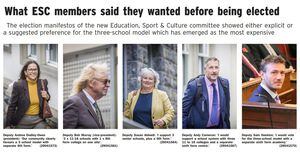‘No perfect solution for the future of secondary schools’
NO model for secondary schools can deliver everything is one of the key findings of an interim report into Guernsey’s secondary schools, and it sets out where compromises could be made.

The investigation was established after Deputy Andrea Dudley-Owen’s ‘pause and review’ requete earlier this year, which followed a well-supported peaceful protest march in Town by campaigners against the two-school model.
The review is ongoing and was due to start looking at the various school models through the lens of ‘different cost brackets’ set at £60m., £70m., £80m., and £90m.
The interim report states that this will allow useful like-for-like comparisons to be made between what can be delivered in each of the models at different levels of expenditure.
‘This will enable an informed decision irrespective of whether the States are willing to spend more or less on secondary education.
‘This is important because it may be that a model which is considered most preferable in the absence of financial information is more expensive, and for any given budget would deliver reduced facilities or compromised educational provision compared to alternatives, which may then become more preferable.
‘Conversely, a model which is not considered preferable but is less expensive could become more preferable with consideration of the additional facilities, or improved education provision, that could be provided at the same cost bracket of a more expensive model.’
The three-school model with three 11-16 schools and a separate sixth form college, was the promised favourite in the election manifestos of the majority of successful candidates, although the financial figures at that stage were not known.
Specifically, the five members of the new Education, Sport & Culture committee either gave explicit preference or a suggested preference to this model in their manifestos.
The review has found that this preferred model is by far the most expensive in terms of capital and running costs.
Consultations with staff have been looking at where compromises could be made, such as reduced sporting facilities, cut backs on communication and autism bases, smaller space standards, and increased average class sizes.
Within the four different school models, modifications within each have also been investigated.
For example, because of requests from union representatives a ‘co-located sixth form college’, which would be separated but not integrated to an 11-16 school, was an idea that was explored.
Under this option the sixth form would remain at Les Varendes and classrooms would be separate, but it was anticipated that staff would teach across the 11-16 and 16-18 phases.
A version of the two-school model, which used Les Varendes instead of Les Beaucamps, was also examined.
